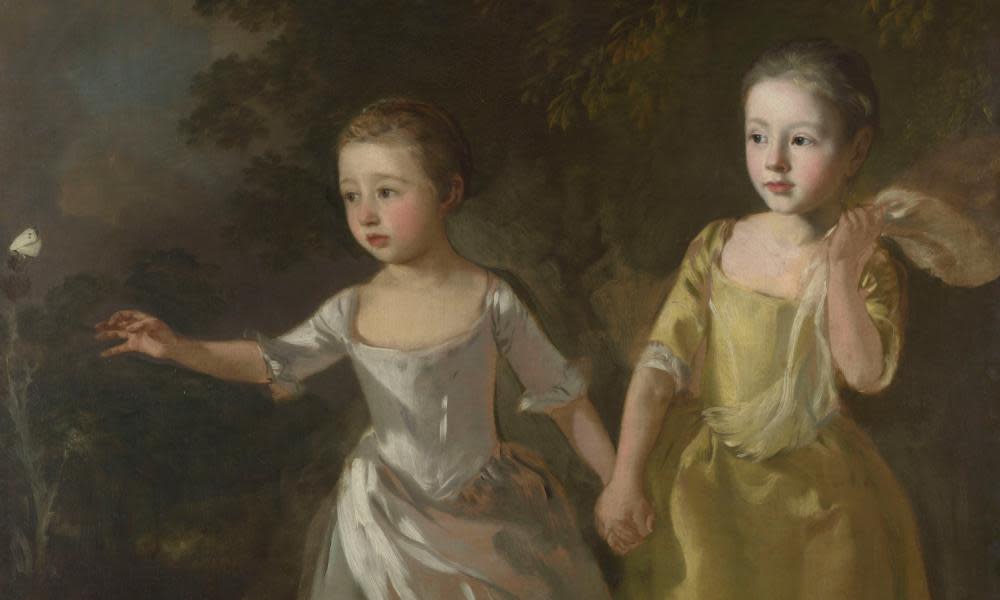Molly & the Captain by Anthony Quinn review – art and obscurity

Molly & the Captain is a tale in three parts, skipping through the centuries from the 1780s to the 1980s. The sections are loosely connected by one fictional portrait: The Merrymount Sisters at Night by William Merrymount, a Gainsborough-esque artist in Georgian Marylebone. The Gainsborough references are frequent and unabashed, “Molly” and “The Captain” being his nicknames for the two cherished daughters he often painted, just as the fictional Merrymount paints his. Laura Merrymount, the elder daughter and “Captain” of this piece, is our first narrator. Although her father encourages her artistic talent she is trapped in his shadow, and the exhibition he persuades her to put on flops. “As a girl I was thought to be fond of Dominion,” she explains in regards to her nickname, but by her mid-30s, disappointed by life and love, she has cast ambition aside.
Anthony Quinn is an attentive author of late 18th-century life, and hits all the expected notes: trips to Bath, dissolute suitors, laudanum. His Lizzie Vavasor, the glamorous actor who befriends Laura, is nicely evocative of real contemporaries such as Dorothea Jordan, while Laura’s narrative is peppered with pleasing Georgian-isms – “chuse”, “partickular”, and best of all “landskips” (for “landscapes”).
This delight in the granular details of an era, as well as a thorough knowledge of its broad sweep, extends into the rest of the novel. The second part, set in raffish 1880s Chelsea, is note-perfect in its portrayal of a young artist, Paul Stransom, and his sister Maggie, who abandoned her own dreams to care for their dying mother. These cash-strapped bohemians are fans of Whistler, and although they count Rossetti and Carlyle among their neighbours, the only one to seize their attention is an unnamed green carnation-wearing resident of Tite Street (a conspiratorial wink to the reader here).
It’s Maggie who first spots an unattributed Regency portrait at auction. Might this be a lost work by William Merrymount himself? “To those in the business of buying and selling it matters very much whose hand it’s by”, but eventually the painting – along with its true creator – is once again dismissed as “not sufficiently splendid to be from the Master’s hand […] and much too fine to be from his daughter’s”.
Onward, to the 1980s, and the novel’s denouement. Quinn once again channels the voice of an era as the citizens of Thatcher’s London “chow down” on chips and peel off their Jordache jeans for nooky. Chelsea, once “a tumbledown village of inns and churches and unpaved roads”, is now full of tourist tat, losing its quirkiness. Kentish Town, the Merrymount sisters’ bluebell-filled backwater, becomes home to another artist, Nell Cantrip, who “happily painted in semi-obscurity” until her work appears on TV and the Sloane Rangers swarm in to buy up her back catalogue.
There are plenty of clever ideas here about artistic fortune and renown, the surges of fashion, and what “obscurity” means to female artists in particular. Nell mistrusts her precarious new popularity; Laura is “quite content to paint on in obscurity” because it shields her from ridicule as a woman in a man’s world. To both, obscurity is a kind of shelter, but the word is also used to diminish and dismiss – what can be more damning than a life of obscurity? What more vindicating than being retrieved from it?
It’s a shame, then, that the plotting is rather predictable and the characters heavy-handed. Obvious facts dawn on them bafflingly late (once “in a starburst of intuitive clarity”). That a Bristolian displays his credentials by saying “gert lush” and “cheers drive!” feels rather too on-the-nose, but hardest to forgive is the way one unfortunate is defined entirely by her fatness. She works her way through packets of biscuits, emits “those extravagant groans of fatigue you’d expect from someone quite ancient”, and sweats copiously as she fats around fatly.
Ultimately this is a novel with interesting things to say about women’s work and talent, and the life cycle of art. The three separate eras are deft pastiches, apposite and well informed, but lacking nuance. The research is clearly careful and thorough, but on the page it veers at points into mimicry, an accomplished performance that somehow wants for sincerity.
• Molly & the Captain by Anthony Quinn is published by Abacus (£16.99). To support the Guardian and the Observer buy a copy at guardianbookshop.com. Delivery charges may apply.


